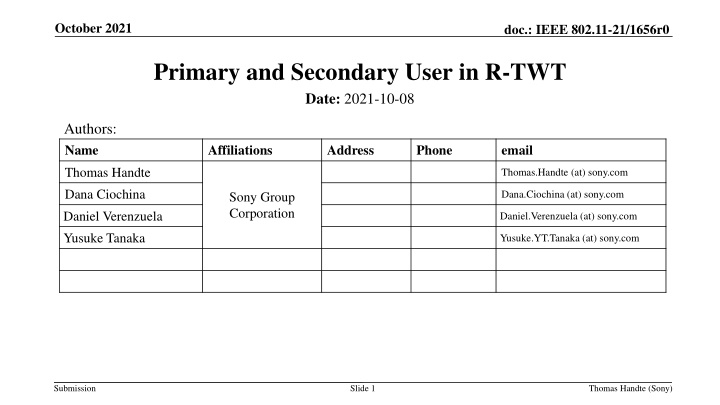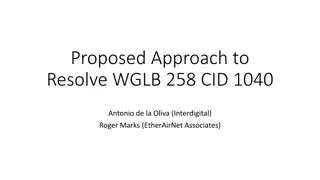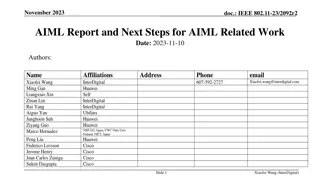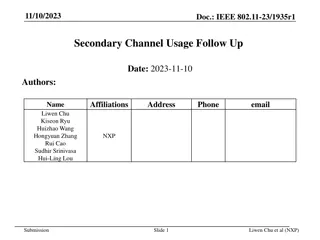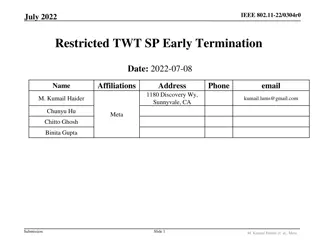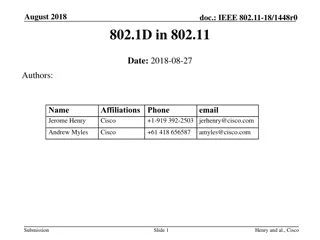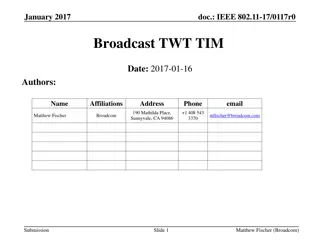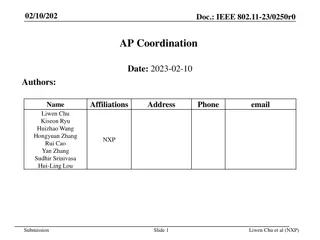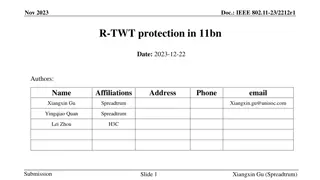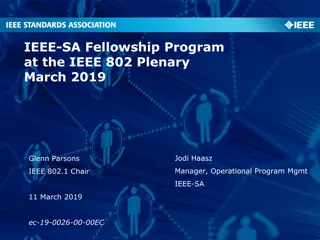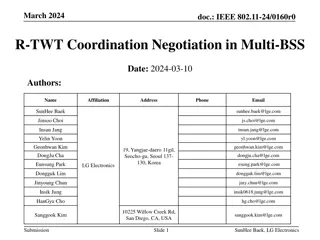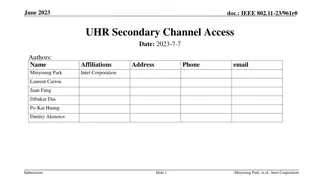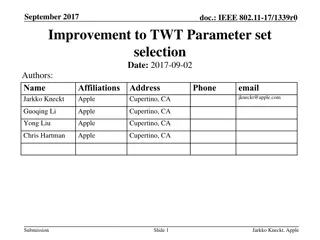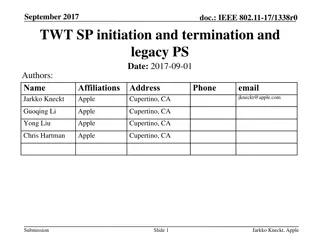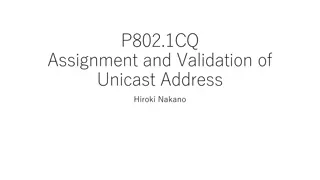IEEE 802.11-21/1656r0: Primary and Secondary User in R-TWT
In October 2021, the document IEEE 802.11-21/1656r0 discusses the usage of R-TWT for low-latency services in 11be TGbe networks. It addresses the coexistence with legacy STAs, transmission delays, and the design challenges related to R-TWT service periods. Various related submissions and CIDs are highlighted, focusing on optimizing R-TWT utilization and managing SP durations effectively.
Download Presentation

Please find below an Image/Link to download the presentation.
The content on the website is provided AS IS for your information and personal use only. It may not be sold, licensed, or shared on other websites without obtaining consent from the author.If you encounter any issues during the download, it is possible that the publisher has removed the file from their server.
You are allowed to download the files provided on this website for personal or commercial use, subject to the condition that they are used lawfully. All files are the property of their respective owners.
The content on the website is provided AS IS for your information and personal use only. It may not be sold, licensed, or shared on other websites without obtaining consent from the author.
E N D
Presentation Transcript
October 2021 doc.: IEEE 802.11-21/1656r0 Primary and Secondary User in R-TWT Date: 2021-10-08 Authors: Name Affiliations Address Phone email Thomas Handte Dana Ciochina Daniel Verenzuela Yusuke Tanaka Thomas.Handte (at) sony.com Dana.Ciochina (at) sony.com Sony Group Corporation Daniel.Verenzuela (at) sony.com Yusuke.YT.Tanaka (at) sony.com Submission Slide 1 Thomas Handte (Sony)
October 2021 doc.: IEEE 802.11-21/1656r0 Introduction Low latency service is an important application scenario for 11be TGbe introduced R-TWT as a protected period for STAs to deliver low-latency data [1, 2] Within a R-TWT service period (SP) the AP may select the STAs that are eligible to transmit the start time is often guaranteed Interference of legacy STAs may be reduced by use of overlapping quiet element While R-TWT framework is good for low latency traffic, the impact to non-low latency traffic should be considered too Even with R-TWT in place, by the nature of operation in unlicensed bands, there is some variance of end-to-end transmission delay caused by Channel access delay Transmit time (e.g. by MCS change) Retransmission time (e.g. retransmission of PPDUs or fraction of it) Therefore, a R-TWT would often be designed with a margin to cover exceptional cases The margin covers delays that exceed the typical transmission delay However, R-TWT SPs designed with a margin are harmful to BSS throughput, because the margin may often be non-used Submission Slide 2 Thomas Handte (Sony)
October 2021 doc.: IEEE 802.11-21/1656r0 Related submissions and CIDs Some related submissions [3, 4, 5] address similar aspect Transmit latency sensitive data first among any other traffic Indication sent by STAs that they are ready for SP termination Terminate R-TWT SP when there is no more LL-traffic [4, 5] Automatically terminate an SP when channel is idle [5] AP to perform prioritization by trigger frame in trigger enabled TWT SP [3] CIDs 5875, 6866, and 7471 [6] address the issue of under utilization of R- TWT SP Submission Slide 3 Thomas Handte (Sony)
October 2021 doc.: IEEE 802.11-21/1656r0 Issue R-TWT SP duration is designed with some margin Target: Successful data delivery is achieved in most cases within R-TWT SP duration Nominal TXOP and contention duration is baseline E.g. based on avg. MCS, MSDU size, contention delay, A reasonable margin is added to the baseline duration depending on statistics E.g. based on 90%-ile of contention delay, retransmission probability, max. TXTIME, The margin may be often unused The higher the margin, the more R-TWT SP duration is mostly unused Submission Slide 4 Thomas Handte (Sony)
October 2021 doc.: IEEE 802.11-21/1656r0 Proposal Concept In R-TWT setup A primary and secondary user set are defined Classification into the two sets may be TID specific Any other STA should not access the R-TWT SP A primary user can contend for channel access right after the R-TWT SP begins shall indicate to secondary users that it finished data transfer e.g. empty queue for specified TID shall not transmit once it issued the indication to secondary users Unless it is a secondary user too A secondary user can contend for channel access after having received a release indication Submission Slide 5 Thomas Handte (Sony)
October 2021 doc.: IEEE 802.11-21/1656r0 Proposal Details Design of the R-TWT SP release indication A 2-step approach is preferable in which the AP releases the R-TWT SP Primary user STA1 indicates to AP that it finished its data transfer The indication (indA) may reside in a subfield (TBD) E.g. queue size = 0 in QoS Control subfield or a reserved bit in CAS Control subfield AP collects STAs indication and transmits a release indication (indB) once all primary user STAs successfully finished their data transfer The indication may be conditional to BAck/Ack response status i.e. indB is only included if BAck indicates success The release indication (indB) may reside in BAck frame (e.g. BA Control field) or in a separate frame (TBD) Submission Slide 6 Thomas Handte (Sony)
October 2021 doc.: IEEE 802.11-21/1656r0 Example R-TWT setup Primary user: STA1 (TID 6), STA2 (TID 4) Both STAs may transfer low-latency data under these TIDs Secondary user: STA3 (any TID) A secondary user STA may rarely obtain a TXOP Therefore, the traffic of a secondary user should not be of type low-latency but rather best effort Operation Each STA indicates with queue size=0 of QoS data frame for the respective TID that no more data is pending for transmission If BAck is success, the AP considers the R-TWT SP as released from the particular STA If BAck indicates an error, the AP considers the R-TWT SP as not released from the particular STA Once all primary user STAs indicated that their queue size is zero, the AP releases to SP to secondary users The BAck comprising the SP release may be a multi-STA BAck Submission Slide 7 Thomas Handte (Sony)
October 2021 doc.: IEEE 802.11-21/1656r0 Special Role of AP The AP is neither a primary nor secondary user It shall collect indications by primary user STAs and release the R-TWT SP It may use EDCA at any time under the following guidelines Any PPDU should only be transmitted to STAs that are either primary or secondary user Downlink BUs for secondary user STAs should only be transmitted once the R-TWT SP is released Trigger frames that trigger secondary user STAs should only be transmitted when the R-TWT SP has been released We believe that guidelines are more appropriate than strict rules, because the AP has all knowledge that it needs for not harming any uplink traffic from a primary user of its BSS The AP should have the flexibility to allocate unused resources to secondary user STAs although the R-TWT SP has not been released Submission Slide 8 Thomas Handte (Sony)
October 2021 doc.: IEEE 802.11-21/1656r0 Benefits The proposed mechanism allows R-TWT to be flexibly and fairly used 1st priority is successful transmission of high priority (low latency) traffic 2nd priority is to utilize remaining duration of R-TWT SP The secondary user set identifies which STAs are eligible to transmit after a release indication and provides the following benefits over SP termination Enhanced contention control After a release indication, the set of STAs that can access the channel is limited to the secondary users In contrast to SP termination, the number of STAs contending for channel access after the release indication can be controlled Enhanced protection of upcoming R-TWT SPs After a SP termination, a non-R-TWT-compliant STAs (e.g. HE STA) may obtain TXOPs Those TXOPs may extend beyond start of next R-TWT SP Enhanced power save STAs that don t belong to primary or secondary user group may be in doze state during the SP No need to listen for TWT SP termination Submission Slide 9 Thomas Handte (Sony)
October 2021 doc.: IEEE 802.11-21/1656r0 Application to time sensitive networking (TSN) Frame Preemption as defined in 802.3br and 802.1Qbu [7] Express frames suspend the transmission of preemptable frames Source or destination of express frames define primary user STAs of a R-TWT SP Source or destination of preemptable frame define secondary user STAs of a R-TWT SP Example: BSS with 3 STAs STA1 and STA2 schedule periodically express frames (e.g. low latency traffic) to be delivered to AP AP, STA1, STA2, STA 3 have preemptable frames (e.g. best effort traffic) queued, too Two persistent R-TWT SPs (#1 and #2) Submission Slide 10 Thomas Handte (Sony)
October 2021 doc.: IEEE 802.11-21/1656r0 Conclusion R-TWT SP may be often underused A significant margin needs to be added to the nominal duration due to the nature of unlicensed bands Proposal R-TWT SP setup defines primary and secondary users Primary users may transmit first Once a primary user finished data transfer, it transmits an indication to AP AP collects all indications and transmits a release indication to all secondary users A secondary user may transmit after having received a release indication by the AP Benefits The R-TWT SP is flexibly and fairly used The secondary user group clearly defines STAs which can expect to receive a release indication Beneficial for contention control, R-TWT protection, and power safe Submission Slide 11 Thomas Handte (Sony)
October 2021 doc.: IEEE 802.11-21/1656r0 SP #1 Do you agree that: TGbe defines a mechanism which allows the remaining time of an R-TWT SP to be used by other STAs once all intended STAs finished their frame exchanges An intended STA is a non-AP STA that may use the R-TWT SP starting from its beginning Submission Slide 12 Thomas Handte (Sony)
October 2021 doc.: IEEE 802.11-21/1656r0 SP #2 Do you agree that: In setup of an R-TWT SP differentiates two user groups A primary user may use the R-TWT SP starting from its beginning A secondary user may use the R-TWT SP once it received a release indication Submission Slide 13 Thomas Handte (Sony)
October 2021 doc.: IEEE 802.11-21/1656r0 SP #3 Do you agree that: Within an R-TWT SP that differentiates primary and secondary user groups A primary user STA shall indicate to an AP that it finished its data transfer An AP shall collect all indications from primary users and transmit a release indication to secondary users once all indications have been received Submission Slide 14 Thomas Handte (Sony)
October 2021 doc.: IEEE 802.11-21/1656r0 References [1] 11-20/1046r12 Protected TWT Enhancement for Latency Sensitive Traffic [2] Draft P802.11be D1.2 [3] 11-21/1020r0 Handling Fairness Issue in Restricted TWT [4] 11-21/1115r0 CC36-CR-35.6 Traffic Prioritization During Restricted TWT SPs [5] 11-21/1358r0 Restricted TWT Termination [6] 11-21/1018r14 IEEE 802.11be CC36 comments [7] 11-18/2027r0 Overview of IEEE 802.1 TSN and IETF DetNet Submission Slide 15 Thomas Handte (Sony)
